Can Solar Energy Power Your Entire Home? An In-Depth Look

Updated 4 months ago
Powering Your Abode with Solar - The Ultimate Guide
Solar energy has transcended beyond a mere eco-friendly alternative, ascending to the forefront of multifaceted home improvement measures. This surge isn't coincidental; with the looming threat of climate change and the erratic nature of utility prices, many homeowners have found solace in the sun's consistent embrace.
In this comprehensive guide, we traverse the solar journey, examining how this technology can not only complement but potentially sustain your entire household's energy demands. And as we sift through the particulars, don't miss the
Does Solar Have the Muscle to Power a Whole House?
Indeed, solar energy bears the potential to entirely supplant traditional power sources for residential use. However, the extent to which it fulfills household needs is contingent upon several factors, including geographical location, household energy consumption, the efficiency of solar panels, and crucially, the size and suitability of your home for solar installation.
Understanding Solar Panel Capacity
Solar panels operate by converting sunlight into electrical energy. Most conventional residential solar panels possess a wattage capacity ranging from 250 to 400 watts. To discern the number of panels necessary, homeowners must gauge their monthly electricity consumption and juxtapose it with their region's average peak sunlight hours.
Estimating Your Energy Consumption
An average household in the United States consumes approximately 877 kilowatt-hours (kWh) per month. By understanding your own energy expenditure (often itemized on your utility bill), and converting this usage into a daily figure, you begin the solar assessment.
Solar Panel Chemistry and Technology
Modern solar panels employ photovoltaic cells, essentially turning your home into a mini power station. This silent and clean energy production means households can also store excess energy in solar batteries for use during overcast days or nighttime.
The Economics of Solar
With financial investment being a significant component, solar installation costs vary, often estimated between $15,000 and $50,000 before accounting for potential tax breaks, rebates, and incentives. Parsing through the nitty-gritty of investment recovery times emphasizes the importance of our
The Dance of Incentives
Tax credits, rebates, and incentives heavily sway the economics of going solar. The United States government, along with several state and municipal entities, offers various fiscal incentives that can significantly lower the upfront costs of solar installations.
Assessing Solar Installation Factors
The complexity of a solar installation is influenced by:
- Rooftop suitability, such as size, pitch, orientation, and type
- Shading from trees or nearby structures
- Panel efficiency, often determined by technological advancements
- Local climate and weather patterns
Choosing the Right Solar Panel
The next step is selecting an apt solar panel for your home. The higher the power output per panel, the fewer numbers you'll need. Panels like SunPower's A-Series boast up to 400 watts per panel, potentially lowering the total number required.
Energy Production Estimates
To estimate the number of solar panels for your home, adopt the methodology of energy assessments, such as the formula:
Desired energy production (kW) / Solar panel wattage (kW) = Number of solar panels needed
This calculation involves knowing the wattage of intended panels and peak sunlight hours in your area – pivotal for an accurate projection.
Factors That Tilt the Scales
Various elements have a bearing on the necessary number of solar panels. This includes your household's energy consumption profile, the output of chosen panels, and local factors like the seasonal shift in sunlight exposure. Mapping out these details will anchor your move towards complete reliance on solar energy.
Going Beyond the Basics
Beyond quantitative figures, qualitative aspects like the condition of your roof and the environmental impact are invaluable during deliberation. Sustainable living doesn't merely reduce your carbon footprint; it also offers a resilient alternative amidst escalating concerns over the reliability of the power grid.
Professional Guidance Elevates Success
To helm this expedition into solar reliance, consulting with professional solar installers is invaluable. Their expertise ensures precision in estimations, optimizes the use of available roof space and sunlight, and addresses unique environmental nuances.
Navigating the Installation Voyage
Here is a stepwise snapshot of what to anticipate:
- Initial Consultation: A deep-dive into your energy needs and solar goals.
- Site Evaluation and Design: Professional assessment of your property and custom system design.
- Permitting and Paperwork: Managing local regulations and incentive applications.
- Installation and Inspection: Skillful setup followed by meticulous inspection.
- Activation and Monitoring: Flipping the switch and ongoing system performance tracking.
Embarking on the solar route doesn't merely signify an adaptation; it heralds an overarching lifestyle transformation.
In Conclusion: Is Full-Spectrum Solar Living Within Reach?
What's become evident is that while the notion of a fully solar-powered house is indeed a tangible possibility, it orbits around several personalized factors. Your daily energy requirements, geographic sunshine bounty, and specific house characteristics all coalesce into a tailored solar solution.
Yearning for an approximation of the solar potential for your home? Flicker not; make use of our specialized
In an age where sustainability defines the boundaries of innovation, a fully solar-powered home is not merely a pleasant possibility—it's a sensible step into the future.




